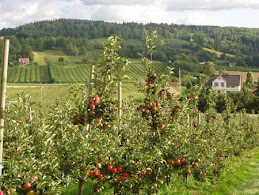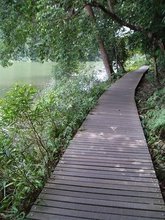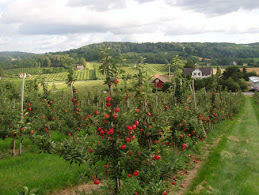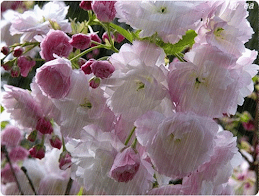Photo: ST
https://blogger.googleusercontent.com/img/b/R29vZ2xl/AVvXsEgId6OCNGmvPP7RLJDJgOGfR27V-bsBl2Alzek80I6AHM4dbacwFJ5ylE1emTsn51j-NKQhnaXQ5MehrjOWs3gizjm4swRIqJC11fiwTPoAiWEzmn9agp3F06J4RJUUZoXW226jQQqEd5A/s1600/20150710_specimen_1.jpg
http://news.asiaone.com/sites/default/files/styles/w848/public/original_images/Jul2015/20150710_specimen_1.jpg?itok=_RFMnbyU
http://news.asiaone.com/news/science-and-tech/vanda-miss-joaquim-mystery-solved
Singapore may have named the Vanda Miss Joaquim its national flower in 1981, but it was not until three decades later that a mystery about its origins was solved.
The orchid had been brought to the Botanic Gardens' first director Henry Ridley in early 1893 by either Miss Agnes Joaquim, an Armenian horticulturalist born in Singapore, or her younger brother Joe.
After examining the orchid, Mr Ridley noted that two other orchids, the Vanda hookeriana and Vanda teres, had been used to create it. But orchids have both male and female parts, so they can be either mother or father to a hybrid.
In the case of the Vanda Miss Joaquim, which Mr Ridley named after Agnes, he wrote: "Unfortunately, no record was kept as to which was used as the male."
The orchid's parentage stayed unclear for more than 100 years, until Dr Gillian Khew joined the Gardens in 2009 and established a new molecular biology laboratory.
The 37-year-old senior researcher worked with others to determine what roles Vanda Miss Joaquim's parents had played.
In a scientific paper published in 2011 outlining her findings, she wrote: "The precise identification of an orchid hybrid's parentage is of utmost importance to botanists, breeders and enthusiasts alike."
Dr Khew told The Straits Times that she sequenced the DNA of specific genes in the orchid that are contributed by only its mother.
Initial tests were done with fresh specimens of Vanda Miss Joaquim. To confirm results, Dr Khew tested a bit of tissue from the original 1893 specimen that been preserved in the Gardens' herbarium.
"Vanda teres was the mother. By elimination, Vanda hookeriana was the father," she said.
While solving the mystery was exciting, Dr Khew said the project is just one of many she has worked on.
Another was to determine where a Brazilian cactus, identified as a new species by the Gardens' current director, Dr Nigel Taylor, fit in the cactus family tree.
"My role is to use DNA sequence information to help classify plants, which helps guide conservation decisions," she said.
The laboratory has a tissue culture section that also plays a major role in conservation, by cloning rare plants and germinating seeds, including orchids. She said: "We mass-produce the plants, sometimes in the thousands, and these are re-introduced to Singapore's streetscapes and parks."
This article was first published on July 10, 2015.
Get a copy of The Straits Times or go to straitstimes.com for more stories.
- https://blogger.googleusercontent.com/img/b/R29vZ2xl/AVvXsEgId6OCNGmvPP7RLJDJgOGfR27V-bsBl2Alzek80I6AHM4dbacwFJ5ylE1emTsn51j-NKQhnaXQ5MehrjOWs3gizjm4swRIqJC11fiwTPoAiWEzmn9agp3F06J4RJUUZoXW226jQQqEd5A/s1600/20150710_specimen_1.jpg
- http://news.asiaone.com/sites/default/files/styles/w848/public/original_images/Jul2015/20150710_specimen_1.jpg?itok=_RFMnbyU
- http://news.asiaone.com/news/science-and-tech/vanda-miss-joaquim-mystery-solved










































.jpg)
.gif)
.jpg)
















































%20-%20%E5%82%B7%E5%BF%83%E7%9A%84%E8%B7%AF%20(Sh%C4%81ng%20x%C4%ABn%20de%20l%C3%B9)%20-%20The%20Road%20of%20Sorrow%20(With%20Subtitle)_11.png)







